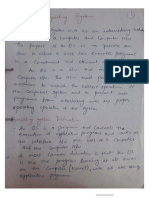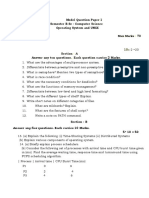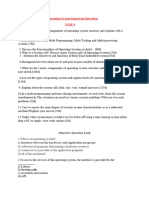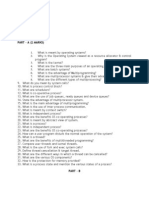0 ratings0% found this document useful (0 votes)
7 viewsQuestion Bank
Question Bank
Uploaded by
Dinal SavajCopyright:
© All Rights Reserved
Available Formats
Download as PDF, TXT or read online from Scribd
Question Bank
Question Bank
Uploaded by
Dinal Savaj0 ratings0% found this document useful (0 votes)
7 views2 pagesOriginal Title
Question Bank.docx
Copyright
© © All Rights Reserved
Available Formats
PDF, TXT or read online from Scribd
Share this document
Did you find this document useful?
Is this content inappropriate?
Copyright:
© All Rights Reserved
Available Formats
Download as PDF, TXT or read online from Scribd
Download as pdf or txt
0 ratings0% found this document useful (0 votes)
7 views2 pagesQuestion Bank
Question Bank
Uploaded by
Dinal SavajCopyright:
© All Rights Reserved
Available Formats
Download as PDF, TXT or read online from Scribd
Download as pdf or txt
You are on page 1of 2
Question Bank
1) Draw and explain five state Process State Transition Diagram.
OR
Draw and explain seven state process state transition diagram in detail.
2) Explain Thread Scheduling with suitable example.
3) What is process? Explain the process creation and termination.
4) What are various criteria for a good process scheduling algorithm? Explain any
two preemptive scheduling algorithms in brief.
OR
List out various criteria for good process scheduling algorithms. Illustrate
non-preemptive priority scheduling algorithm.
5) Explain the following Linux commands: (1) mkdir (2) touch (3) cat (4) rm
5)grep 6)sort 7)chmod 8)mkdir.
6) What is process? Explain process control block with all parameters.
7) What is scheduling? Explain the types of schedulers.
8) Differentiate process and thread.
9) Write a shell script to find factorial of an user-defined natural number.
10) List and briefly define four classes of real-time scheduling algorithms.
11) Five batch jobs A, B, C, D and E arrive at same time. They have estimated
running times 10, 6, 3, 4 and 8 ms. For each of the following algorithm determine
mean process turnaround time. Consider process swapping overhead is 1 ms.
1) FCFS
2) Round-Robin (Time quantum = 2 ms)
12) Five batch jobs P1, P2, P3, P4 and P5 arrive at 0, 1, 2, 3 and 4 ms. They have
estimated running times 14, 12, 8, 3 and 6 ms. Their priorities are 3, 5, 2, 1 and 4
respectively with 5 being highest priority. For each of the following algorithm
determine mean process turnaround time. Consider process swapping overhead is
0.5 ms. 1) SJF (Non-preemptive) 2) Priority Scheduling (Preemptive)
13) Describe the differences among long-term scheduling. short-term, and
medium- term scheduling.
14) Define multi-threading? Explain its benefits. OR What are the advantages of
multiprogramming?
15) Demonstrate FIFO and Round Robin CPU scheduling algorithms with suitable
example.
16) What is thread? Explain classical thread model.
17) Define preemption and nonpreemption.
18) Explain the Priority scheduling algorithm.
19) Differentiate between Windows and Linux file system.
20) What is the thread? What are the difference between user-level threads and
kernel supported threads? Under what circumstances is one type “better” than the
other?
21) Define the difference between preemptive and nonpreemptive scheduling.
22) What are the disadvantages of FCFS scheduling algorithm as compared to
shortest job first (SJF) scheduling?
You might also like
- CPPC 10 Lecture Notes 2 Process ManagementDocument16 pagesCPPC 10 Lecture Notes 2 Process ManagementBlessious Joseph LandoyNo ratings yet
- Gandhinagar Institute of Technology: Computer Engineering DepartmentDocument6 pagesGandhinagar Institute of Technology: Computer Engineering Departmentshah mananNo ratings yet
- OSDocument148 pagesOSA K SharmaNo ratings yet
- Operating SystemDocument3 pagesOperating Systempsaravanan1985No ratings yet
- Os Latest 5 Years QuestionDocument4 pagesOs Latest 5 Years Questionnikhilmahato526No ratings yet
- ALM1Document2 pagesALM1hexoka9508No ratings yet
- Os Model ExamDocument2 pagesOs Model ExamSurya NatarajanNo ratings yet
- RTOS Question Bank-1Document13 pagesRTOS Question Bank-1SIDDESHWAR VASAM0% (1)
- Operating System 150 MarksDocument4 pagesOperating System 150 MarksShreyashNo ratings yet
- Os Upload 3Document2 pagesOs Upload 3dusravalorantNo ratings yet
- Discussion on CPU schedulingDocument4 pagesDiscussion on CPU schedulinghimanshujhaa4262No ratings yet
- OS Important QuestionsDocument4 pagesOS Important QuestionsnallagattuchittiNo ratings yet
- Assignment Os NewDocument4 pagesAssignment Os NewSupriya KumarNo ratings yet
- Os Question Bank NewDocument7 pagesOs Question Bank Newshetty.sinchana2208No ratings yet
- C Byregowda Institute of Technology: Tutorial Question-1Document2 pagesC Byregowda Institute of Technology: Tutorial Question-1shirisha gowdaNo ratings yet
- 10 M Os Question BankDocument4 pages10 M Os Question Bankrifathmuzammilshaik24No ratings yet
- KCS401 - OS - Final Question BankDocument6 pagesKCS401 - OS - Final Question Bankparidhiagarwal129No ratings yet
- OSQBMid Apr 2023Document3 pagesOSQBMid Apr 2023napimo5076No ratings yet
- Operating Systems Question BankDocument10 pagesOperating Systems Question BankAman AliNo ratings yet
- OS Imp 1&2Document3 pagesOS Imp 1&2sudhanshu18shekar10No ratings yet
- OS AssignmentDocument2 pagesOS Assignmentansh parasharNo ratings yet
- Os-Paper-Imp-Q Sem 4Document2 pagesOs-Paper-Imp-Q Sem 4WednesdayNo ratings yet
- Operating System Important QuestionsDocument3 pagesOperating System Important Questionsskhamshu22f01a4456No ratings yet
- OS Question Bank 1Document10 pagesOS Question Bank 1Murali SkpecNo ratings yet
- Madhuben & Bhanubhai Patel Institute of Technology AY:2020-21 Term: Even Semester: IV Operating System (3140702) Question BankDocument6 pagesMadhuben & Bhanubhai Patel Institute of Technology AY:2020-21 Term: Even Semester: IV Operating System (3140702) Question BankBlessy ParmarNo ratings yet
- Model Papers IV Sem Comp SciDocument6 pagesModel Papers IV Sem Comp ScidebasiskamilaNo ratings yet
- Operating SystemsDocument23 pagesOperating Systemsmounika.avirineniNo ratings yet
- Q Bank OSDocument6 pagesQ Bank OSMohsena ShahinNo ratings yet
- os mid questionsDocument8 pagesos mid questionsKandula AnushaNo ratings yet
- Operating System Previous Question PaperDocument10 pagesOperating System Previous Question Paperbuisness7503No ratings yet
- Os Super-Imp-Tie-22 (1) PDFDocument4 pagesOs Super-Imp-Tie-22 (1) PDFChandana H.RNo ratings yet
- Question Bank - Operating SystemDocument4 pagesQuestion Bank - Operating SystemPrince PatelNo ratings yet
- Semester:-Sem IV Branch: - Computer Science and Engineering Subject: - Operating SystemDocument14 pagesSemester:-Sem IV Branch: - Computer Science and Engineering Subject: - Operating SystemYash SugandhiNo ratings yet
- Operating Systems Question Bank For TwoDocument15 pagesOperating Systems Question Bank For Twovkalaiselvi.engineeringNo ratings yet
- Os - Midexam - Syllabus & Que - BankDocument4 pagesOs - Midexam - Syllabus & Que - Banknapimo5076No ratings yet
- Btech Cs 4 Sem Operating System Btcoc403 May 2019 (1) DBATuDocument2 pagesBtech Cs 4 Sem Operating System Btcoc403 May 2019 (1) DBATusagar patoleNo ratings yet
- 5CS4-03 - Operating System - Kajal MathurDocument157 pages5CS4-03 - Operating System - Kajal MathurIshaan KhandelwalNo ratings yet
- Operating System Question Bank For Unit 1&2Document9 pagesOperating System Question Bank For Unit 1&2SRIHITHA YELISETTINo ratings yet
- Cpu Scheduling AssignmentDocument3 pagesCpu Scheduling AssignmentJoséphNo ratings yet
- Osy - Vimp - V2VDocument7 pagesOsy - Vimp - V2VVishnu MaskarNo ratings yet
- OsDocument3 pagesOsaditipatil2404No ratings yet
- OS Question BankDocument3 pagesOS Question BankTadi VyshnaviNo ratings yet
- Question Bank (OS I)Document3 pagesQuestion Bank (OS I)Black AdamNo ratings yet
- Question bank on 4,5,6Document3 pagesQuestion bank on 4,5,6Disha ChaudhariNo ratings yet
- 2023 Os Model QPDocument16 pages2023 Os Model QPbjbhargav600No ratings yet
- Sybca Os Question BankDocument17 pagesSybca Os Question Bankpranavkhatake8No ratings yet
- OPERATING SYSTEM 2019-May - CSD-222 - 99Document2 pagesOPERATING SYSTEM 2019-May - CSD-222 - 99Sahil SoodNo ratings yet
- MCS 041Document4 pagesMCS 041shivshankar shahNo ratings yet
- Exercise 4Document4 pagesExercise 4Mashavia AhmadNo ratings yet
- Mock paper by diploma helperDocument3 pagesMock paper by diploma helperr6810088No ratings yet
- Unit 2,3 Ct2 Question Bank 4 MarksDocument3 pagesUnit 2,3 Ct2 Question Bank 4 MarksAKASH V (RA2111003040108)No ratings yet
- cs604 Previous Semesters Papers Subjective Collect (SalMan HaidEr )Document6 pagescs604 Previous Semesters Papers Subjective Collect (SalMan HaidEr )syedahsan727559No ratings yet
- Operating System Sample Paper MergedDocument27 pagesOperating System Sample Paper Mergedsurajmore2368No ratings yet
- Operating System Sample Paper 5th Semester MSBTE Diploma in Computer Engineering GroupDocument2 pagesOperating System Sample Paper 5th Semester MSBTE Diploma in Computer Engineering GroupSanjay Dudani69% (13)
- ICS 2102 - Operating systems concepts - November 2019Document3 pagesICS 2102 - Operating systems concepts - November 2019p.githinji.atlNo ratings yet
- Unit - I Part - A (2 Marks)Document9 pagesUnit - I Part - A (2 Marks)kashokcse16No ratings yet
- AOS_PracticeQuestions_1Document5 pagesAOS_PracticeQuestions_1NarasimYNo ratings yet
- CP 226 Cpu Scheduling AssignmentDocument6 pagesCP 226 Cpu Scheduling Assignmentwell responsiveNo ratings yet
- Performance Evaluation by Simulation and Analysis with Applications to Computer NetworksFrom EverandPerformance Evaluation by Simulation and Analysis with Applications to Computer NetworksNo ratings yet
- Chapter 16: Concurrency ControlDocument12 pagesChapter 16: Concurrency ControlshadwekNo ratings yet
- Difference Between Object Lock and Class LockDocument3 pagesDifference Between Object Lock and Class Lockshivprakashjob14No ratings yet
- Cse 325 - Operat LabDocument2 pagesCse 325 - Operat LabRajesh NahakNo ratings yet
- Review of OS ConceptsDocument100 pagesReview of OS Conceptsvinay dattaNo ratings yet
- C++ Concurrency CheatsheetDocument1 pageC++ Concurrency Cheatsheetslacka123100% (1)
- ch08 DeadlocksDocument47 pagesch08 Deadlockstmdgn0214No ratings yet
- Answer:: The Different Components of DDBMS Are As FollowsDocument9 pagesAnswer:: The Different Components of DDBMS Are As FollowsAqab ButtNo ratings yet
- Taxonomy Parallel Computer Architectures Instruction DataDocument2 pagesTaxonomy Parallel Computer Architectures Instruction DataAnonymous YsVh1JJY9TNo ratings yet
- SMK NEGERI 6 GARUT - Penetapan - NhunDocument27 pagesSMK NEGERI 6 GARUT - Penetapan - NhunVanhas Ibnu AbbasNo ratings yet
- Distributed Shared MemoryDocument30 pagesDistributed Shared Memorymani_madhukar3654No ratings yet
- FinalDocument26 pagesFinalHứa Đăng KhoaNo ratings yet
- C++ With Pthreads: Ryan M. Swanstrom December 27, 2008Document8 pagesC++ With Pthreads: Ryan M. Swanstrom December 27, 2008hamid TalibNo ratings yet
- Byte Python Concurrent and Parallel Programming V2Document38 pagesByte Python Concurrent and Parallel Programming V2Cherry BlossomNo ratings yet
- Internet Programming Chapter4Document46 pagesInternet Programming Chapter4abenezer g/kirstosNo ratings yet
- Chapter 10 DbmsDocument9 pagesChapter 10 DbmsSaloni VaniNo ratings yet
- Comp ArchitectureDocument17 pagesComp ArchitectureUsman MalikNo ratings yet
- On Optimistic Methods For Concurrency ControlDocument20 pagesOn Optimistic Methods For Concurrency ControlJohn ReiNo ratings yet
- Process Synchronization Chapter-4Document31 pagesProcess Synchronization Chapter-4Mehar BhagatNo ratings yet
- Introduction To Deadlock: Difference Between Starvation and DeadlockDocument12 pagesIntroduction To Deadlock: Difference Between Starvation and DeadlockHappy SadNo ratings yet
- Student Handwritten NotesDocument48 pagesStudent Handwritten Notesvedchaturvedi0001No ratings yet
- Laplante Ch3 UpdatedDocument45 pagesLaplante Ch3 UpdatedAdugna NegeroNo ratings yet
- Isolation LevelDocument17 pagesIsolation LevelSushma Reddy VNo ratings yet
- Transactions Concurrency Control Phase Control Protocol Log Based Recovery Deadlock Two Phase Locking ProtocolDocument67 pagesTransactions Concurrency Control Phase Control Protocol Log Based Recovery Deadlock Two Phase Locking ProtocolSiddharth SinghNo ratings yet
- Work-Sharing Constructs Loop ConstructDocument9 pagesWork-Sharing Constructs Loop ConstructVariable 14No ratings yet
- Threads in JavaDocument67 pagesThreads in JavaNishant RajNo ratings yet
- Designing With RTOS: Task CommunicationDocument9 pagesDesigning With RTOS: Task CommunicationBhuvana GowdaNo ratings yet
- Multi-Tasking in Python - Speed Up Your Program 10x by Executing Things Simultaneously - by Mike Huls - Towards Data ScienceDocument18 pagesMulti-Tasking in Python - Speed Up Your Program 10x by Executing Things Simultaneously - by Mike Huls - Towards Data Sciencemarkus.aureliusNo ratings yet
- Answers To Final ExamDocument4 pagesAnswers To Final ExamSyed Mohammad RizwanNo ratings yet
- 06 - Interprocess CommunicationDocument21 pages06 - Interprocess CommunicationmuhammadusmanshabqadarNo ratings yet

























































































